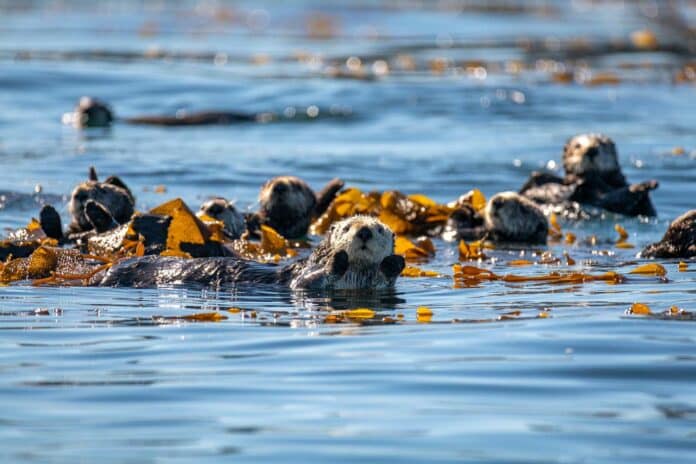Kelp forest ecosystems face threats worldwide, which play a crucial role in marine environments and provide essential services. Canopy-forming kelps are the cornerstone of unique marine ecosystems, found in every ocean basin and covering 25% of temperate and arctic coastlines.
Despite their significance in global carbon budgets, kelp forests are not currently part of blue carbon initiatives.
Kelp forests’ condition and susceptibility to climate change hold global importance. As the basis for diverse and productive ecosystems, comprehending long-term trends in kelp forests is vital for managing coastal ecosystems, enhancing climate resilience, and developing restoration programs. Protecting and understanding these ecosystems is crucial for maintaining the health and balance of our oceans.
In a recent study published in Plos Climate, scientists aimed to create spatially explicit historical reference points for California kelp forest cover and understand the primary drivers of change over the last century. They utilized historical data from early 20th-century U.S. government ship-based surveys, specifically those focused on commercial resources along the Pacific coast.
Contemporary estimates of kelp canopy were derived from aerial surveys conducted by the California Department of Fish and Wildlife (CDFW). These surveys used high-resolution multispectral imagery, downscaled to 2m resolution, and converted into shapefiles representing kelp polygons. Standardized monitoring occurred during the fall season, ensuring peak kelp abundance and minimizing factors such as tidal currents, fog, and glare.
Scientists employed ArcGIS tools to overlay 2014, 2015, and 2016 shapefiles to create a contemporary dataset comparable to the historical survey. They then generated a new layer by outlining the union of kelp polygons. This outlined shapefile replicated the resolution and structure of the historical “harvestable” kelp bed, achieved through smoothing pixelated vector data originating from high-resolution raster imagery and excluding specific polygons.
Scientists next used the “intersect” function to calculate regional mean polygon overlap values between the unioned. They outlined contemporary kelp shapefiles for correction factors for estimating kelp canopy area from the historical maps. To create a comparably scaled statewide historical benchmark, they discounted the area of each harvestable kelp bed from the 1910–1912 surveys by applying the correction factors for northern, central, and southern California.
Scientists overlayed both georeferenced surveys with a 500 m linear coastal transect to compare the historical vector and contemporary raster datasets. This linearized binning of the California coastline, from Mexico (0 km) to the Oregon border (1,620 km), is our geospatial framework for all datasets and analyses. Scientists then characterized century-scale changes in kelp forests along California’s mainland coast by calculating the difference between recent (2014–2016) and historical (1910–1912) canopy area within each 500 m unit.
These statewide comparisons, however, mask dramatic regional changes with increases in Central California (+57.6%, +19.7 km2) and losses along the Northern (-63.0%, -8.1 km2), and Southern (-52.1%, -18.3 km2) mainland coastlines. Random Forest models rank sea otter (Enhydra lutris nereis) population density as the primary driver of kelp changes, with benthic substrate, extreme heat, and high annual variation in primary productivity also significant.
Scientists identified four important findings by examining environmental factors related to century-scale, spatially resolved kelp canopy changes along California’s mainland coastline. First, although overall statewide canopy decline was low, regional changes were dramatic, with central California kelp forest gains nearly offsetting losses along northern and southern mainland coastlines.
Second, sea otters outweighed all other environmental factors, representing a strong driver of kelp forest gains by increasing canopy resilience to impacts from more detrimental factors. Third, in the absence of sea otters, extreme heat, high variation in NPP, and soft benthic substrate corresponded most with declines.
Fourth, they translated our kelp area metrics to carbon accounting and social costs to assess the importance of kelp ecosystems and their climate resiliency in global conservation and policy frameworks.
Scientists noted, “Our identification of substantial regional declines in kelp canopy over the last century suggests staggering alterations of California’s coastline, capturing not only recent losses in northern California, but mid-century decreases along the southern transect. However, this may reflect a fraction of true losses incurred during the last two centuries when considering effects of nineteenth-century grassland erosion from cattle grazing and crop cultivation along southern California coastal watersheds.”
“By the early 1900s, rapid, unmanaged agricultural development yielded an estimated 10-fold increase in sediment deposition from the Los Angeles and Orange county alluvial plain, smothering historically abundant marine granite substrate and complex benthos formed by millennia of shelled invertebrates and gravel, which may have provided suitable substrate to support extensive offshore kelp forests. After 1900, port excavations, inadequate wastewater management, and shallow sewage outfalls degraded nearshore kelp beds off the southern California coastline during dramatic, mid-twentieth century human population growth.”
“Our findings suggest that managing terrestrial land use is an important component of maintaining and restoring the health of marine and coastal ecosystems, alongside managing contemporary impacts from warming oceans.”
Journal Reference:
- Nicholson TE, McClenachan L, Tanaka KR, Van Houtan KS (2024) Sea otter recovery buffers century-scale declines in California kelp forests. PLOS Clim 3(1): e0000290. DOI: 10.1371/journal.pclm.0000290
